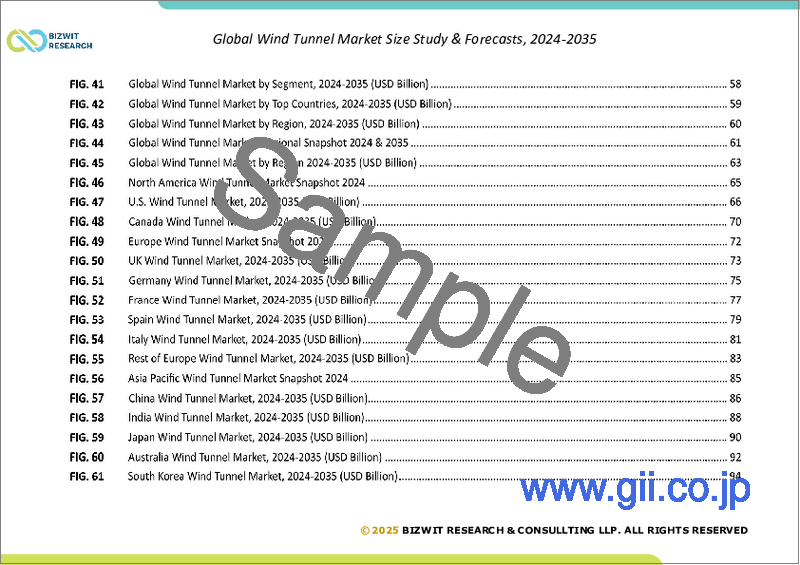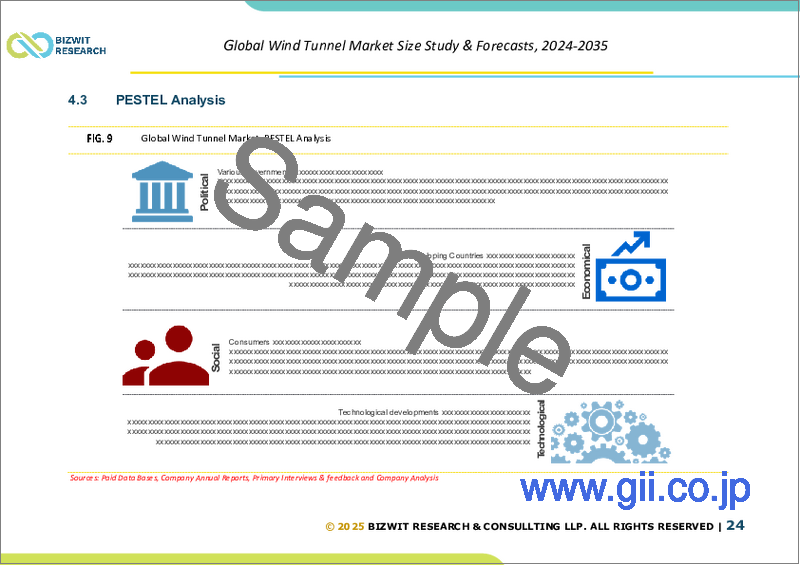|
|
市場調査レポート
商品コード
1763838
風洞の世界市場:市場規模の分析 (種類別、用途別、エンドユーザー別、地域別) と将来予測 (2025~2035年)Global Wind Tunnel Market Size Study & Forecast, by Type, Application, End-User, and Regional Forecasts 2025-2035 |
||||||
カスタマイズ可能
|
|||||||
| 風洞の世界市場:市場規模の分析 (種類別、用途別、エンドユーザー別、地域別) と将来予測 (2025~2035年) |
|
出版日: 2025年07月07日
発行: Bizwit Research & Consulting LLP
ページ情報: 英文 285 Pages
納期: 2~3営業日
|
- 全表示
- 概要
- 目次
世界の風洞市場は、2024年に約22億9,000万米ドルと評価され、予測期間中(2025~2035年)に3.56%の複合年間成長率(CAGR)で上昇すると予想されています。
風洞は、物体の空気力学的挙動を再現するために設計された高度に専門化された調査装置であり、航空宇宙、自動車、建設、スポーツ工学の技術革新の基礎となっています。これらの施設は、物体の周りの空気の動きをシミュレートし、エンジニアが実物大の生産や実地試験を必要とせずに、車両、建物、設備の空力性能を試験、改良、最適化できるようにします。この市場の主な原動力は、防衛航空分野における研究開発の復活、モータースポーツや高速車両開発における利用の拡大、オリンピックレベルのスポーツ科学における風洞の役割の増大です。
風洞システムの需要曲線は、オープンサーキットとクローズドサーキットの両方のトンネルタイプにおける最先端のアプリケーションによって押し上げられつつあります。航空宇宙・防衛産業は、次世代戦闘機、無人航空機、再使用可能な打ち上げロケットに投資しており、風洞データが提供する精度は不可欠です。さらに、建設業界はこれらの施設を活用して、特に高層インフラで、風による振動や構造荷重に耐える建物の空気力学をテストしています。持続可能性への懸念から、自動車メーカーが排出ガス削減のために空気力学的効率性を重視するようになるにつれ、風洞は自動車設計において再び重要性を増しています。同時に、オリンピックのトレーニングプログラムやスポーツ用品の開発に携わる機関は、エリートアスリートや用具の性能を向上させるために、風洞シミュレーションを活用しています。
地域別では、北米が引き続き市場をリードしており、航空宇宙企業、政府系防衛関連企業、資金力のある学術研究施設が存在感を示しています。米国は依然として技術革新の要であり、NASA、軍部隊、民間航空宇宙大手が航空力学研究に継続的に投資を行っています。欧州は、ドイツ、フランス、英国などの国々が、自動車、航空、建築工学など多くの分野で風洞試験を展開しており、堅調な市場として続いています。一方、アジア太平洋は、中国とインドが航空宇宙プログラムとインフラストラクチャー・ポートフォリオを急速に拡大しており、ダイナミックな競合国として台頭してきています。また、中東諸国では、防衛用途や未来的な都市アーキテクチャの開発に風洞技術の採用を検討し始めています。
当レポートの目的は、近年のさまざまなセグメントと国の市場規模を明らかにし、今後数年間の市場規模を予測することです。当レポートは、分析対象国における業界の質的・量的側面の両方を盛り込むよう設計されています。また、市場の将来的な成長を規定する促進要因や課題などの重要な側面に関する詳細な情報も提供しています。さらに、主要企業の競合情勢や製品提供の詳細な分析とともに、利害関係者が投資するためのミクロ市場における潜在的な機会も組み込んでいます。市場の詳細なセグメントとサブセグメントは以下の通りです:
目次
第1章 世界の風洞市場:分析範囲・手法
- 分析目的
- 分析手法
- 予測モデル
- 机上分析
- トップダウンとボトムアップのアプローチ
- 分析の属性
- 分析範囲
- 市場の定義
- 市場区分
- 分析前提条件
- 包含と除外
- 制限事項
- 分析対象期間
第2章 エグゼクティブサマリー
- CEO/CXOの立場
- 戦略的洞察
- ESG分析
- 主な分析結果
第3章 世界の風洞市場:力学分析
- 世界の風洞市場を左右する市場力学(2024~2035年)
- 促進要因
- 航空宇宙・防衛での研究開発の復活
- 自動車・建設業界における空力効率の需要
- 抑制要因
- 高額な設備投資と運用コスト
- 風洞の建設・調整の長いリードタイム
- 機会
- スポーツとオリンピックのテストプログラムの拡大
- デジタルツインとシミュレーション技術の導入
第4章 世界の風洞産業の分析
- ポーターのファイブフォース分析
- 買い手の交渉力
- サプライヤーの交渉力
- 新規参入業者の脅威
- 代替品の脅威
- 競争企業間の敵対関係
- ポーターのファイブフォース:予測モデル(2024~2035年)
- PESTEL分析
- 政治的
- 経済的
- 社会的
- 技術的
- 環境的
- 法的
- 主な投資機会
- 主要成功戦略(2025年)
- 市場シェア分析(2024~2025年)
- 世界の価格分析と動向(2025年)
- アナリストの提言と結論
第5章 世界の風洞の市場規模・予測:種類別(2025~2035年)
- 市場概要
- 世界市場の業績:潜在力分析(2025年)
- 開回路風洞
- 閉回路風洞
第6章 世界の風洞の市場規模・予測:用途別(2025~2035年)
- 市場概要
- 世界市場の業績:潜在力分析(2025年)
- 航空宇宙・防衛
- 自動車
- スポーツ・オリンピック
- 建設業
- その他
第7章 世界の風洞の市場規模・予測:エンドユーザー別(2025~2035年)
- 市場概要
- 世界市場の業績:潜在力分析(2025年)
- 研究機関
- 政府
第8章 世界の風洞の市場規模・予測:地域別(2025~2035年)
- 地域市場のスナップショット
- 主要先進国・新興国
- 北米
- 米国
- カナダ:セグメント別内訳(2025~2035年)
- 欧州
- 英国:セグメント別内訳(2025~2035年)
- ドイツ:セグメント別内訳(2025~2035年)
- フランス:セグメント別内訳(2025~2035年)
- スペイン:セグメント別内訳(2025~2035年)
- イタリア:セグメント別内訳(2025~2035年)
- その他欧州:セグメント別内訳(2025~2035年)
- アジア太平洋
- 中国:セグメント別内訳(2025~2035年)
- インド:セグメント別内訳(2025~2035年)
- 日本:セグメント別内訳(2025~2035年)
- オーストラリア:セグメント別内訳(2025~2035年)
- 韓国:セグメント別内訳(2025~2035年)
- その他アジア太平洋:セグメント別内訳(2025~2035年)
- ラテンアメリカ
- ブラジル:セグメント別内訳(2025~2035年)
- メキシコ:セグメント別内訳(2025~2035年)
- 中東・アフリカ
- UAE:セグメント別内訳(2025~2035年)
- サウジアラビア:セグメント別内訳(2025~2035年)
- 南アフリカ:セグメント別内訳(2025~2035年)
- その他中東・アフリカ:セグメント別内訳(2025~2035年)
第9章 競合情報
- 主要市場の戦略
- Boeing
- 企業概要
- 主要幹部
- 企業のスナップショット
- 財務実績(データの入手可能性によります)
- 製品/サービスポート
- 最近の開発
- 市場戦略
- SWOT分析
- Airbus S.A.S.
- Lockheed Martin Corporation
- RUAG Group
- DNW(German-Dutch Wind Tunnels)
- Mitsubishi Heavy Industries
- Honda R&D Co., Ltd.
- Calspan Corporation
- Tesla, Inc.
- Mahle GmbH
- Canadian National Research Council(NRC)
- BMT Group Ltd.
- ONERA(The French Aerospace Lab)
- Aerolab, LLC
- Jacobs Engineering Group
The Global Wind Tunnel Market was valued at approximately USD 2.29 billion in 2024 and is expected to ascend at a compound annual growth rate (CAGR) of 3.56% over the forecast timeline from 2025 to 2035. Wind tunnels-highly specialized research instruments designed to replicate the aerodynamic behavior of objects-have become foundational to innovation in aerospace, automotive, construction, and sports engineering. These facilities simulate air movement around objects, enabling engineers to test, refine, and optimize the aerodynamic performance of vehicles, buildings, and equipment without needing full-scale production or field trials. The market is primarily driven by the resurgence of R&D in defense aviation, growing use in motorsports and high-speed vehicle development, and the increasing role of wind tunnels in Olympic-level sports science.
The demand curve for wind tunnel systems is being pushed higher by cutting-edge applications across both open-circuit and closed-circuit tunnel types. With the aerospace and defense industry investing in next-generation fighter jets, unmanned aerial vehicles, and reusable launch vehicles, the precision offered by wind tunnel data remains indispensable. Furthermore, the construction industry is leveraging these facilities to test building aerodynamics for resilience against wind-induced vibrations and structural loads, especially for high-rise infrastructure. As sustainability concerns steer vehicle manufacturers toward aerodynamic efficiency to reduce emissions, wind tunnels are gaining renewed relevance in automotive design. Simultaneously, institutions involved in Olympic training programs and sporting goods development are turning to wind tunnel simulations to unlock incremental performance advantages in elite athletes and equipment.
Regionally, North America continues to spearhead the market, fortified by the presence of established aerospace corporations, governmental defense contractors, and well-funded academic research facilities. The United States remains the linchpin of innovation, with NASA, military branches, and private aerospace giants persistently channeling investments into aerodynamics research. Europe follows as a robust market, with countries like Germany, France, and the UK deploying wind tunnel testing across a multitude of sectors including automotive, aviation, and building engineering. Meanwhile, Asia Pacific is emerging as a dynamic contender, with China and India rapidly expanding their aerospace programs and infrastructure portfolios. Additionally, Middle Eastern countries are beginning to explore the adoption of wind tunnel technology for both defense applications and the development of futuristic urban architectures.
Major market player included in this report are:
- Boeing
- Airbus S.A.S.
- Lockheed Martin Corporation
- RUAG Group
- DNW (German-Dutch Wind Tunnels)
- Mitsubishi Heavy Industries
- Honda R&D Co., Ltd.
- Calspan Corporation
- Tesla, Inc.
- Mahle GmbH
- Canadian National Research Council (NRC)
- BMT Group Ltd.
- ONERA (The French Aerospace Lab)
- Aerolab, LLC
- Jacobs Engineering Group
Global Wind Tunnel Market Report Scope:
- Historical Data - 2023, 2024
- Base Year for Estimation - 2024
- Forecast period - 2025-2035
- Report Coverage - Revenue forecast, Company Ranking, Competitive Landscape, Growth factors, and Trends
- Regional Scope - North America; Europe; Asia Pacific; Latin America; Middle East & Africa
- Customization Scope - Free report customization (equivalent up to 8 analysts' working hours) with purchase. Addition or alteration to country, regional & segment scope*
The objective of the study is to define market sizes of different segments & countries in recent years and to forecast the values for the coming years. The report is designed to incorporate both qualitative and quantitative aspects of the industry within the countries involved in the study. The report also provides detailed information about crucial aspects, such as driving factors and challenges, which will define the future growth of the market. Additionally, it incorporates potential opportunities in micro-markets for stakeholders to invest, along with a detailed analysis of the competitive landscape and product offerings of key players. The detailed segments and sub-segments of the market are explained below:
By Type:
- Open Circuit Wind Tunnel
- Closed Circuit Wind Tunnel
By Application:
- Aerospace and Defense
- Automotive
- Sports and Olympics
- Construction
- Others
By End-User:
- Research Institutions
- Government
By Region:
- North America
- U.S.
- Canada
- Europe
- UK
- Germany
- France
- Spain
- Italy
- Rest of Europe
- Asia Pacific
- China
- India
- Japan
- Australia
- South Korea
- Rest of Asia Pacific
- Latin America
- Brazil
- Mexico
- Middle East & Africa
- UAE
- Saudi Arabia
- South Africa
- Rest of Middle East & Africa
Key Takeaways:
- Market Estimates & Forecast for 10 years from 2025 to 2035.
- Annualized revenues and regional level analysis for each market segment.
- Detailed analysis of geographical landscape with Country level analysis of major regions.
- Competitive landscape with information on major players in the market.
- Analysis of key business strategies and recommendations on future market approach.
- Analysis of competitive structure of the market.
- Demand side and supply side analysis of the market.
Table of Contents
Chapter 1. Global Wind Tunnel Market Report Scope & Methodology
- 1.1 Research Objective
- 1.2 Research Methodology
- 1.2.1 Forecast Model
- 1.2.2 Desk Research
- 1.2.3 Top-Down and Bottom-Up Approach
- 1.3 Research Attributes
- 1.4 Scope of the Study
- 1.4.1 Market Definition
- 1.4.2 Market Segmentation
- 1.5 Research Assumptions
- 1.5.1 Inclusion & Exclusion
- 1.5.2 Limitations
- 1.5.3 Years Considered for the Study
Chapter 2. Executive Summary
- 2.1 CEO/CXO Standpoint
- 2.2 Strategic Insights
- 2.3 ESG Analysis
- 2.4 Key Findings
Chapter 3. Global Wind Tunnel Market Forces Analysis
- 3.1 Market Forces Shaping the Global Wind Tunnel Market 2024-2035
- 3.2 Drivers
- 3.2.1 Resurgence of Aerospace & Defense R&D
- 3.2.2 Demand for Aerodynamic Efficiency in Automotive & Construction
- 3.3 Restraints
- 3.3.1 High Capital Expenditure and Operating Costs
- 3.3.2 Long Lead Times for Tunnel Construction and Calibration
- 3.4 Opportunities
- 3.4.1 Expansion of Sports and Olympic Testing Programs
- 3.4.2 Adoption of Digital Twin and Simulation Technologies
Chapter 4. Global Wind Tunnel Industry Analysis
- 4.1 Porter's Five Forces Model
- 4.1.1 Bargaining Power of Buyers
- 4.1.2 Bargaining Power of Suppliers
- 4.1.3 Threat of New Entrants
- 4.1.4 Threat of Substitutes
- 4.1.5 Competitive Rivalry
- 4.2 Porter's Forecast Model 2024-2035
- 4.3 PESTEL Analysis
- 4.3.1 Political
- 4.3.2 Economic
- 4.3.3 Social
- 4.3.4 Technological
- 4.3.5 Environmental
- 4.3.6 Legal
- 4.4 Top Investment Opportunities
- 4.5 Top Winning Strategies 2025
- 4.6 Market Share Analysis 2024-2025
- 4.7 Global Pricing Analysis and Trends 2025
- 4.8 Analyst Recommendations & Conclusion
Chapter 5. Global Wind Tunnel Market Size & Forecasts by Type 2025-2035
- 5.1 Market Overview
- 5.2 Market Performance - Potential Analysis 2025
- 5.3 Open Circuit Wind Tunnel
- 5.3.1 Top Countries Breakdown - Estimates & Forecasts, 2024-2035
- 5.3.2 Market-Size Analysis by Region, 2025-2035
- 5.4 Closed Circuit Wind Tunnel
- 5.4.1 Top Countries Breakdown - Estimates & Forecasts, 2024-2035
- 5.4.2 Market-Size Analysis by Region, 2025-2035
Chapter 6. Global Wind Tunnel Market Size & Forecasts by Application 2025-2035
- 6.1 Market Overview
- 6.2 Market Performance - Potential Analysis 2025
- 6.3 Aerospace and Defense
- 6.3.1 Top Countries Breakdown - Estimates & Forecasts, 2024-2035
- 6.3.2 Market-Size Analysis by Region, 2025-2035
- 6.4 Automotive
- 6.4.1 Top Countries Breakdown - Estimates & Forecasts, 2024-2035
- 6.4.2 Market-Size Analysis by Region, 2025-2035
- 6.5 Sports and Olympics
- 6.6 Construction
- 6.7 Others
Chapter 7. Global Wind Tunnel Market Size & Forecasts by End-User 2025-2035
- 7.1 Market Overview
- 7.2 Market Performance - Potential Analysis 2025
- 7.3 Research Institutions
- 7.3.1 Top Countries Breakdown - Estimates & Forecasts, 2024-2035
- 7.3.2 Market-Size Analysis by Region, 2025-2035
- 7.4 Government
Chapter 8. Global Wind Tunnel Market Size & Forecasts by Region 2025-2035
- 8.1 Regional Market Snapshot
- 8.2 Top Leading & Emerging Countries
- 8.3 North America
- 8.3.1 U.S. - Segment Breakdown, 2025-2035
- 8.3.2 Canada - Segment Breakdown, 2025-2035
- 8.4 Europe
- 8.4.1 UK - Segment Breakdown, 2025-2035
- 8.4.2 Germany - Segment Breakdown, 2025-2035
- 8.4.3 France - Segment Breakdown, 2025-2035
- 8.4.4 Spain - Segment Breakdown, 2025-2035
- 8.4.5 Italy - Segment Breakdown, 2025-2035
- 8.4.6 Rest of Europe - Segment Breakdown, 2025-2035
- 8.5 Asia Pacific
- 8.5.1 China - Segment Breakdown, 2025-2035
- 8.5.2 India - Segment Breakdown, 2025-2035
- 8.5.3 Japan - Segment Breakdown, 2025-2035
- 8.5.4 Australia - Segment Breakdown, 2025-2035
- 8.5.5 South Korea - Segment Breakdown, 2025-2035
- 8.5.6 Rest of Asia Pacific - Segment Breakdown, 2025-2035
- 8.6 Latin America
- 8.6.1 Brazil - Segment Breakdown, 2025-2035
- 8.6.2 Mexico - Segment Breakdown, 2025-2035
- 8.7 Middle East & Africa
- 8.7.1 UAE - Segment Breakdown, 2025-2035
- 8.7.2 Saudi Arabia - Segment Breakdown, 2025-2035
- 8.7.3 South Africa - Segment Breakdown, 2025-2035
- 8.7.4 Rest of MEA - Segment Breakdown, 2025-2035
Chapter 9. Competitive Intelligence
- 9.1 Top Market Strategies
- 9.2 Boeing
- 9.2.1 Company Overview
- 9.2.2 Key Executives
- 9.2.3 Company Snapshot
- 9.2.4 Financial Performance (Subject to Data Availability)
- 9.2.5 Product/Services Portfolio
- 9.2.6 Recent Developments
- 9.2.7 Market Strategies
- 9.2.8 SWOT Analysis
- 9.3 Airbus S.A.S.
- 9.4 Lockheed Martin Corporation
- 9.5 RUAG Group
- 9.6 DNW (German-Dutch Wind Tunnels)
- 9.7 Mitsubishi Heavy Industries
- 9.8 Honda R&D Co., Ltd.
- 9.9 Calspan Corporation
- 9.10 Tesla, Inc.
- 9.11 Mahle GmbH
- 9.12 Canadian National Research Council (NRC)
- 9.13 BMT Group Ltd.
- 9.14 ONERA (The French Aerospace Lab)
- 9.15 Aerolab, LLC
- 9.16 Jacobs Engineering Group






